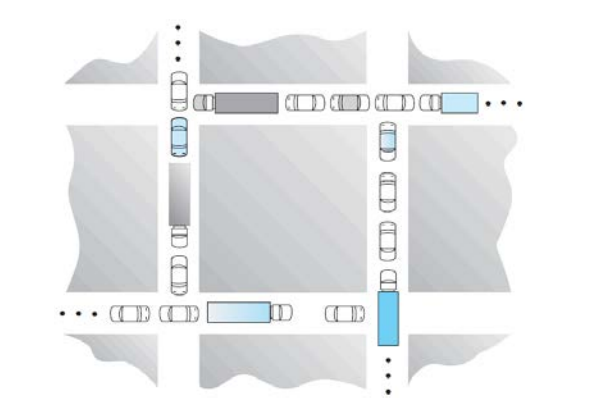Consider the traffic deadlock depicted in follow figure.

a. Show that the four necessary conditions for deadlock indeed hold in this example.
b. State a simple rule for avoiding deadlocks in this system.
- a.
1. mutual exclusion: 每条道路都只能让一个方向的车通行,且车之间不可能穿透而过。
2. hold and wait: 四个方向的车辆都占有一条道路,并等待另一方向的车露出空隙。
3. no preemption: 每个方向的车都必须等待另一个方向的车主动倒车,无法强迫。
4. circular wait:每个方向的车互相等待,形成一个环。
- b. 安排一位交警选择并指挥一个方向的车让出道路。
Consider a system consisting of four resources of the same type that are shared by three processes, each of which needs at most two resources. Show that the system is deadlock free.
答:反证法,假设形成了死锁。则由每个进程最多需求 2 个资源实例,和死锁必要条件中的 3,4 点可知,唯一的情形是:三个进程各自占有一个资源且等待另一个资源,并形成了一个环。而在该情况下,剩余的一个资源导致死锁不会发生。
Consider a system consisting of m resources of the same type being shared by n processes. Resources can be requested and released by processes only one at a time. Show that the system is deadlock free if the following two conditions hold:
- a. The maximum need of each process is between 1 and m resources.
- b. The sum of all maximum needs is less than m + n.
$ a. \sum_{i=1}^n Max_i < m+n $
$ b. Max_i \geq 1 for all i $
$ c. Need_i = Max_i − Allocation_i $
If there exists a deadlock state then:
$ d. \sum_{i=1}^n Allocation_i = m $
$ a,b,c,d \Rightarrow \sum_{i=1}^n Need_i < n $
This implies that there exists a process $ P_i $ such that $ Need_i = 0 $. Since $ Max_i >= 1 $, it follows that $ P_i $ has at least one resource, the deadlock can't maintain.
Consider the following snapshot of a system:
| PID |
AL. |
|
|
|
MAX |
|
|
|
|
A |
B |
C |
D |
A |
B |
C |
D |
| P0 |
0 |
0 |
1 |
2 |
0 |
0 |
1 |
2 |
| P1 |
1 |
0 |
0 |
0 |
1 |
7 |
5 |
0 |
| P2 |
1 |
3 |
5 |
4 |
2 |
3 |
5 |
6 |
| P3 |
0 |
6 |
3 |
2 |
0 |
6 |
5 |
2 |
| P4 |
0 |
0 |
1 |
4 |
0 |
6 |
5 |
6 |
(p.s. AL.= Allocated:, AV.= Available)
Answer the following questions using the banker's algorithm:
a. What is the content of the matrix Need?
b. Is the system in a safe state?
c. If a request from process $ P_1 $ arrives for (0,4,2,0), can the request be granted immediately?
- a
| PID | need | | | |
| --- | --- | - | - | - |
| | A | B | C | D |
| P0 | 0 | 0 | 0 | 0 |
| P1 | 0 | 7 | 5 | 0 |
| P2 | 1 | 0 | 0 | 2 |
| P3 | 0 | 0 | 2 | 0 |
| P4 | 0 | 6 | 4 | 2 |
- b 由银行家算法可知是安全的,序列\(<0,2,1,3,4>\)为安全序列。
- c 假设满足,则$ Need_{P_1} =(0,11,7,0) \(,序列\) <0,2,3,4,1> $为安全序列,故可立即满足。
Consider a system with four processes$ P_1, P_2, P_3$ and $ P_4 $, and two resources, $ R_1, R_2 $ respectively. Each resource has two instances. Furthermore:
$ P_1 $ allocates an instance of $ R_2 $ , and requests an instance of $ R_1 $ ;
$ P_2 $ allocates an instance of $ R_1 $ , and doesn’t need any other resource;
$ P_3 $ allocates an instance of $ R_1 $ and requires an instance of $ R_2 $ ;
$ P_4 $ allocates an instance of $ R_2 $ , and doesn’t need any other resource.
Answer the following questions:
a. Draw the resource allocation graph.
b. Is there a cycle in the graph? If yes name it.
c. Is the system in deadlock? If yes, explain why. If not, give a possible sequence of executions after which every process completes.
